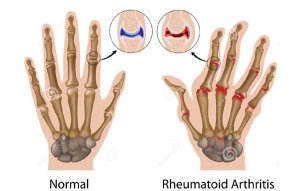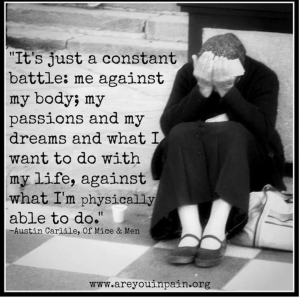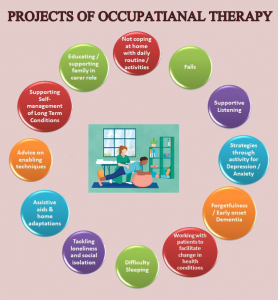
What is Rheumatoid Arthritis?
Rheumatoid arthritis (RA) is a recurring disease that damages the musculoskeletal system over time. Neuromuscular control is weakened by RA, particularly in the hands. RA often damages the joints of our body symmetrically, resulting in a drop in muscle strength and a progressive decline in hand functionality. RA affects 1-2 percent of the world’s population, with women between the ages of 20 and 65 having a rate two to three times greater than men. Joint structure and function make it difficult to perform daily chores due to the generative process of RA as it causes pain and joint stiffness. The inflammation caused by RA interferes directly with the individual’s functional activity, muscle strength, and the function of the neuromuscular system (Coelho-Oliveira, A. et al., 2021).
Symptoms & Signs
Rheumatoid Arthritis spreads throughout the body and affects areas such as the wrists, knees, ankles, elbows, hips, and shoulders. Some signs and symptoms may include:
- Edema, pain, tenderness

- Joint stiffness (due to inactivity)
- Fatigue, fever, and weight loss
RA can also affect many non-joint structures, including:
- Skin, eyes, lungs, heart
- Kidneys, salivary glands
- Nerve tissue, Bone marrow, Bone vessels
Management & Treatments
Rheumatoid Arthritis is developed by our immune system. Our immune systems start attacking our body’s tissues the synovium – the membrane that surrounds our joints. It results in the thickening of the synovium which destroys the cartilage and bone within the joint.
The complete cause of RA is still unknown. There is no cure for RA, but it can be treated with physiotherapy and medication to slow the disease’s progression. It can be managed with medications such as Nonsteroidal anti-inflammatory drugs, and NSAIDs.
Psychosocial Concerns on individuals with RA

Non-inflammatory pain in RA patients includes mechanical pain (such as osteoarthritis), neuropathic pain, fibromyalgia, therapeutic side effects, and psychosocial consequences such as depression, anxiety, sleep difficulties, exhaustion, sexual dysfunction, and incapacity.
Occupational Therapy & Rheumatoid Arthritis

What is Occupational Therapy? Occupational therapy focuses on engaging individuals with disabilities to perform meaningful tasks.
The goal of occupational therapy in all disorders including RA is to make a patient as self-sufficient as possible in both daily life activities and social involvement. For an occupational therapist, it is critical to concentrate on the issues that patients care about the most. For individuals with RA, occupational therapy follows a set of guidelines, such as lowering discomfort and preventing excessive joint stress through a variety of methods, including, behavioral modification, the use of assistive devices and splints, and environmental adaptability (Malcus-Johnson P. et al., 2005).
To simplify, an occupational therapist helps individuals with a disability that affects their main occupation or tasks that are meaningful to them such as dressing, eating, working, and or school activities by adapting to their environment, and tasks based on the individual’s level of functioning.
An occupational therapist will use different strategies to help individuals with Rheumatoid Arthritis by creating:
- Joint protection from further decline
- Compensatory strategies
- Home modifications & adaptations
- Splinting program
Community Resources

Arthritis Foundation provides services:
- Treatments options
- Health care providers
- Diets
- Exercise programs
- Coping with changes ( relationships, caregiving, work, etc)
- Comorbidities (depression, eye diseases, diabetes, etc)
- Pain management
References:
Arthritis foundation: Donate for a cure. Arthritis Foundation | Donate for a Cure. (n.d.). Retrieved May 8, 2022, from https://www.arthritis.org/donate?utm_content=brand&gclid=cjwkcajwve2tbhbyeiwaaktm1l8vpbvsnlotiofkdeoijsoud5cmrbha73qxcyya2yqcybbv-6i0xhoc6juqavd_bwe
Coelho-Oliveira, A. C., Lacerda, A. C. R., de Souza, A. L. C., Santos, L. M. de M., da Fonseca, S. F., dos Santos, J. M., Ribeiro, V. G. C., Leite, H. R., Figueiredo, P. H. S., Fernandes, J. S. C., Martins, F., Filho, R. G. T., Bernardo-Filho, M., da Cunha de Sá-Caputo, D., Sartorio, A., Cochrane, D., Lima, V. P., Costa, H. S., Mendonça, V. A., & Taiar, R. (2021). Acute Whole-Body Vibration Exercise Promotes Favorable Handgrip Neuromuscular Modifications in Rheumatoid Arthritis: A Cross-Over Randomized Clinical. BioMed Research International, 1–10. https://doi.org/10.1155/2021/9774980
Essentials of Human Diseases and Conditions, 6th Ed. Frazier, M.S. & Drzymkowski, J.W.,
Kuijper TM, Luime JJ, Xiong H, de Jong P, van der Lubbe P, van Zeben D, Tchetverikov I, Hazes J, & Weel A. (2018). Effects of psychosocial factors on monitoring treatment effect in newly diagnosed rheumatoid arthritis patients over time: response data from the tREACH study. Scandinavian Journal of Rheumatology, 47(3), 178–184. https://doi.org/10.1080/03009742.2017.1349176
Malcus-Johnson P, Carlqvist C, Sturesson A, & Eberhardt K. (2005). Occupational therapy during the first 10 years of rheumatoid arthritis. Scandinavian Journal of Occupational Therapy, 12(3), 128–135. https://doi.org/10.1080/11038120510031716
Tonga E, Duger T, & Karatas M. (2016). Effectiveness of client-centered occupational therapy in patients with rheumatoid arthritis: exploratory randomized controlled trial. Archives of Rheumatology, 31(1), 6–13. https://doi.org/10.5606/ArchRheumatol.2016.5478
